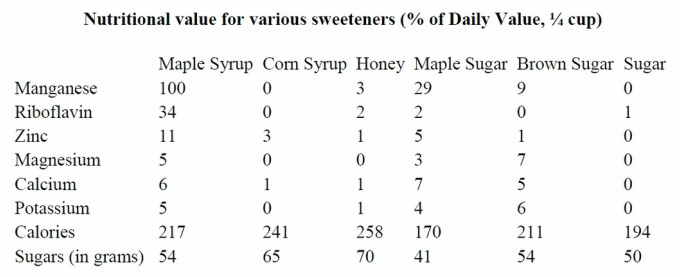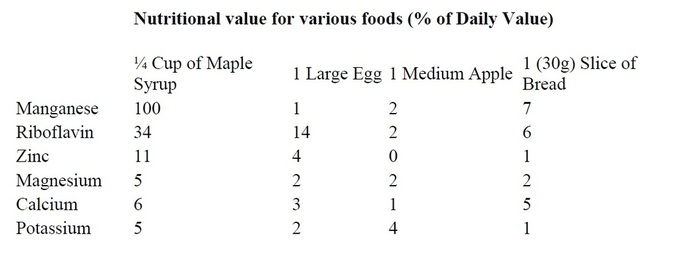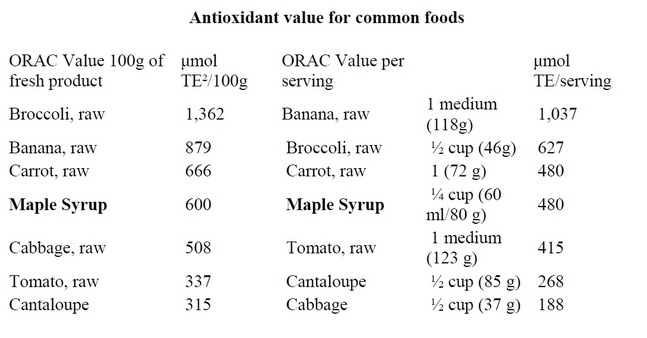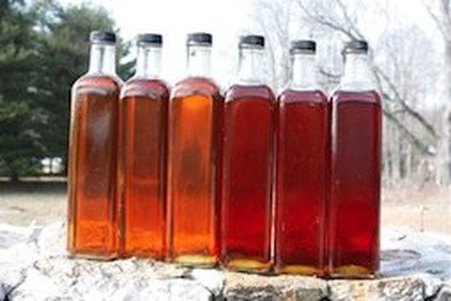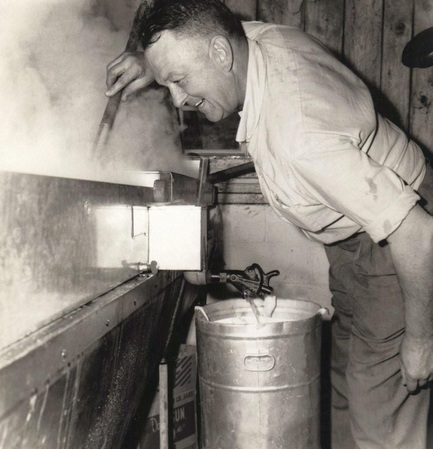 Oliver L. Scranton, Maple Grove Farm, North Guilford (c. 1960). New England winters can be interminable. By the time February rolls around, the skies are gray and the snow is brown. March shows signs of warmer weather as thin sheets of ice stretch across the frozen mud. I understand why some people don’t like this time of year. But growing up, the weeks between Presidents’ Day and St. Patrick’s Day were a sweet, golden amber dream known as maple syrup season. By age seven, I was an integral part of the sugaring operations at Maple Grove Farm in North Guilford, Connecticut. Maple sugaring was a family affair, and each one of us had a role to play. I was the tour guide, and I took my job very seriously. I would show visitors the sap buckets and collection tanks, let them taste the clear, sugar-water-flavored sap and explain the entire sugaring off process. Everything I knew I had learned from my grandfather, whom I adored. He taught me that it was the Native Americans who shared the secrets of maple syrup production with our ancestors, even though there were plenty of sugar maples in Europe. He taught me that the sap runs when cold nights alternate with warm days – and that the sap stops running when the leaves start developing. Finally, he taught me the show stopping statistic that was guaranteed to get a low whistle: it takes 40 gallons of sap to make just one gallon of syrup. While I loved being a tour guide, the best time of day was after the visitors left. My cousins, nine and eleven, and I would go with my grandfather to collect the sap. The two boys would dump buckets of sap into the collection tank on the trailer. I sat with my grandfather, occasionally steering the big green John Deere tractor through the fields. As the sun set, we would finish collecting the sap and head back to the sugar house. Sometimes we’d have pancakes for dinner, with a little bit of hot maple syrup drawn right from the evaporator. Other times we’d have chili or stew – which meant that dessert would be a maple syrup taffy made by pouring maple syrup onto fresh snow and letting it chill enough to become a sweet, flexible treat. My grandfather died in 1984, a few months shy of my tenth birthday. As good Yankees, we didn’t talk about everything we had lost. Instead, we tapped trees, hung buckets, strung up tubing and stacked the wood that would fuel the evaporator. These simple acts gave us a sense of purpose and brought us together at a time when the strain of caring for my grandmother, who had severe Alzheimer’s, threatened to tear the family apart completely. In that small sugar house, over stacks of pancakes smothered in hot syrup, we shared our stories – breaking with one tradition while upholding another. By age seven, Erica Holthausen was the official tour guide for maple syruping operations at Maple Grove Farm in North Guilford, Connecticut. A marketing mentor and freelance writer, this article first appeared as a part of a Food Memories book published as part of A Life in Context Project.
Maple syrup may not yet be classified as a health food, but it’s getting close! Research results, mostly coming out of Canada and based in large part on work done at the University of Rhode Island, are showing that maple syrup delivers nutritional benefits superior to other common sweeteners and that it compares very favorably to some common “healthy” foods on a nutritional value basis. Here are two comparisons that support these points. There is more. Antioxidants are best known for their health effects in disease prevention, including neurological diseases, heart diseases and some forms of cancer. Maple syrup compares favorably in this context versus some of the healthiest foods. To me, the most significant fact in the above comparisons lies with corn syrup. In various forms it is in many of the foods we consume from potato chips to ketchup to beef (beef cattle are fattened in feedlots on a diet of corn). And, of course, it is the only sweetener in table syrups like Aunt Jemima. Evidence is growing that corn syrup is not only basically empty calories, but it may be the primary cause of the current obesity epidemic. I am not in favor of banning corn syrup from the American diet or maple syrup replacing it in potato chips or, for that matter, gasoline where a corn derivative takes the name of ethanol, but I do want a bigger share of the sweeteners that are poured on pan cakes and waffles!!!! Maple syrup has fewer calories per serving and provides a lot more nutritional value than corn syrup.
MSPAC Member Elliott Davis recently got a little maple syrup publicity! His farm in Washington was profiled by Mommy Poppins! The Davis family has added maple syruping to their farming adventures -- along with a flock of 25 chickens, herd of Icelandic sheep and 2 beehives. To read more about this small family farm, see the full piece at Mommy Poppins.
At sugarhouses across Connecticut, local school children learn about the traditions of maple sugaring in New England. The history of maple sugaring is rooted in the land and was practiced by the Native American Tribes who lived here before us. I know you’re in the middle of sugarin’ now in Connecticut and I know you are planning your open houses and we know you are also taking care of families, full time jobs, life in general so, just asking you to pass the word about MSPAC and CT Maple and the international meeting coming up and Ag Day and all that jazz.
An association like ours is only as good as the efforts of folk who are part of it and promote the wonderful things each other is doing. Promoting MSPAC puts your craft of sugar making in a good light and that is a bonus in more ways than one. If anyone has ideas for Art Roy and I about a few eye catching things we can put on the table during Ag Day at the capitol, let us know…small space, people go by quickly, we need punch for a pint so to speak. If you've never seen the magic of tapping a maple tree, you really have to see these videos. Above, a drill is used to tap the tree -- and a small pipe cleaner cleans out the wood before a spile is inserted. Below, the sap starts running!
…well sort of. Happy Groundhog’s Day! Spring looks like it’s here. If you look at the temps for the coming week you’ll see it looks like the sap will be running as well. Please check out the Maple Syrup Producer’s Association page on Facebook, contribute to this blog if you wish, send me some photos, tell us your news, keep in touch on the forum of Maple Trader, share your knowledge and joys of sugaring and some of the things to avoid as well (like Stack Burn!).
We only have 4-6 weeks and then toss sugaring back up to the folks more north of us so let’s have a blast! Even if you’ve never made Maple Syrup before or if you have one tap on a lone tree in your backyard come February, you are encouraged to attend tomorrow’s meeting. You can glean little tidbits, learn from the pros, take away great information, enjoy meeting some new friends and most of all, be inspired to make great use of what nature gives us in abundance every spring, SAP! Go to CTMaple.org for directions to the meeting in Haddam. Hope to see you there, it’ll be a sweet time!
|
- Home
- About
- Maple Weekend
- Where to buy CT Maple Products - List By Town
- Connecticut Sugar Houses Map
- Membership & Joining
-
- MSPAC Annual Meeting - november
- Plymouth Maple Festival
- MSPAC Pre-Season Meeting - January
- Bright Acres Farm Open House
- Blue Slope Maple Festival
- Hebron Maple Festival
- Flanders Nature Center
- Stamford Museum's Maple Sugar Festival
- Ag Day at Capitol in Hartford
- Sweet WInd Farm Maple Festival
- Eastern CT Maple Festival
- Cookbook
- Contact
- Blog
- Home
- About
- Maple Weekend
- Where to buy CT Maple Products - List By Town
- Connecticut Sugar Houses Map
- Membership & Joining
-
- MSPAC Annual Meeting - november
- Plymouth Maple Festival
- MSPAC Pre-Season Meeting - January
- Bright Acres Farm Open House
- Blue Slope Maple Festival
- Hebron Maple Festival
- Flanders Nature Center
- Stamford Museum's Maple Sugar Festival
- Ag Day at Capitol in Hartford
- Sweet WInd Farm Maple Festival
- Eastern CT Maple Festival
- Cookbook
- Contact
- Blog

